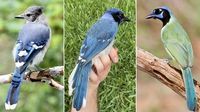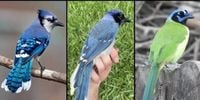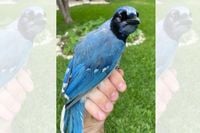In the sun-dappled suburbs of San Antonio, Texas, a backyard bird feeder has become the unlikely stage for a scientific first: the confirmed discovery of a wild hybrid between a green jay and a blue jay. This so-called “grue jay”—a nickname that’s quickly catching on among birders—has captured the attention of ornithologists and climate scientists alike, not just for its striking plumage but for what its existence reveals about a rapidly changing world.
According to SciTechDaily, scientists at The University of Texas at Austin have documented what may be the first observed vertebrate hybrid resulting directly from two species expanding their ranges in response to climate change. Brian Stokes, a graduate student in ecology, evolution, and behavior at UT and lead author of the study, explained, “We think it’s the first observed vertebrate that’s hybridized as a result of two species both expanding their ranges due, at least in part, to climate change.” For decades, these two species—separated by roughly 7 million years of evolution—lived in entirely different neighborhoods. Green jays, tropical birds with vivid emerald masks, were rarely seen north of the Rio Grande, while blue jays, with their crisp blue tails and bold white wing spots, were a fixture of the eastern United States, their range stopping well short of Texas’s heartland.
But the world has been warming, and the birds have been moving. As CNN reports, since the 1950s, green jays have crept northward from Mexico and southern Texas, while blue jays have sidled west, possibly drawn by suburban sprawl and the bounty of backyard bird feeders. By the early 2000s, these two species found their ranges overlapping for the first time in living memory—right in the San Antonio area. Timothy Keitt, a professor of integrative biology at UT Austin and coauthor of the study, noted that birders across Central Texas began sharing sightings of green jays on social media and platforms like eBird, marking their northward advance by more than 100 miles and about two degrees of latitude.
It was one such social media post that set this scientific adventure in motion. In May 2023, while scanning birding groups online for his doctoral research, Stokes stumbled upon a blurry photo of a bird that looked almost—but not quite—like a blue jay. The bird’s blue feathers and white wing spots were familiar, but its black mask and a telltale spot over the eye hinted at green jay ancestry. “He happened to notice that this person posted a picture of this odd jay, and immediately told me, and we got in the car and drove down to find it right away,” Keitt recalled to CNN.
Capturing the bird proved to be a test of patience and ingenuity. Jays, members of the corvid family, are notoriously clever. The first day, Stokes and Keitt had no luck. But on the second day, the hybrid blundered into a mist net—a nearly invisible mesh stretched between two poles—and was quickly, gently caught. Stokes drew a blood sample for genetic analysis, banded the bird’s leg, and released it back into the suburban wild. The bird then vanished for a few years, only to reappear in the same backyard in June 2025. “I don’t know what it was, but it was kind of like random happenstance,” Stokes told SciTechDaily. “If it had gone two houses down, probably it would have never been reported anywhere.”
Back in the lab, the researchers compared the bird’s DNA to that of both species and confirmed what the field marks had suggested: the bird was the offspring of a male blue jay and a female green jay. The finding was published on September 10, 2025, in the journal Ecology and Evolution. The hybrid displayed a mix of traits from both parents. Its back and tail were blue, like a blue jay, but it lacked the species’ spiky crown and instead sported a green jay’s distinctive eye spot. Its calls were a blend too—sometimes the familiar jeer of a blue jay, sometimes the clicks and rattles unique to green jays. The bird even followed blue jay flocks, but would occasionally break into the vocal stylings of its tropical side.
Hybridization in birds is not unheard of—ducks, for instance, are famous for mixing it up. But as The Straits Times points out, corvids like jays are different. They’re known for their intelligence, strong pair bonds, and keen ability to recognize both their own species and even individual humans. “Both of these jay species form long-term social bonds with a mate,” said Professor Gavin Leighton, a biologist at Buffalo State University who studies bird hybridization. “We would expect them to be pretty choosy about who they form these pair bonds with.” Leighton described the discovery as “a biological curveball.”
So how did it happen? Leighton speculated that timing and circumstance played a role. “If they aren’t having good luck finding an individual in their own species that is also without a mate, then maybe there’s a higher risk of making a mistake,” he told CNN. The overlap of their ranges is a recent phenomenon, likely less than a decade old, and attributed to a mix of climate change—warmer nights making Texas more hospitable to tropical species—and human-driven habitat modification. Backyard feeders, suburban landscaping, and shifting weather have all contributed to bringing these unlikely parents together.
This isn’t the first time a blue jay and green jay have produced offspring, but it is the first time it’s happened in the wild. In the 1960s, researchers managed to cross the two species in captivity, and that specimen now resides in the Fort Worth Museum of Science and History. But as Keitt and Stokes note, the current discovery is different: this hybrid is alive, banded, and haunting the backyards of San Antonio, a living symbol of ecological change.
The researchers chose not to give the bird an official scientific name, but among birders, “grue jay” (a playful blend of “green” and “blue”) is gaining traction. It joins the quirky ranks of other hybrid nicknames like “grolar bear” (polar bear-grizzly), “coywolf” (coyote-wolf), and “narluga” (narwhal-beluga). As Stokes observed, “Hybridization is probably way more common in the natural world than researchers know about because there’s just so much inability to report these things happening.”
What does the future hold for the grue jay and its kin? That remains an open question. Keitt wonders whether blue and green jays will continue to hybridize as their ranges overlap further, or whether they’ll become better at distinguishing themselves as neighbors. For now, the grue jay stands as an improvised, uneasy ambassador from a future in which climate change and human activity are redrawing the boundaries of the natural world—sometimes in ways that surprise even the cleverest of birds.



